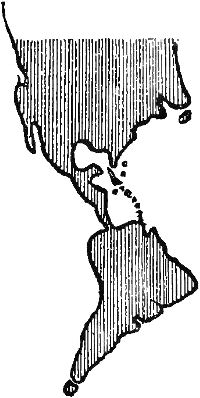the contour of the eastern coasts of the American continent,

placing the head at Newfoundland, the knees at Cape St. Roque, and the feet at Cape Horn, it is easy to perceive that they are identical. The shallow basin held on the belly of the statue, between the hands, would then be symbolical of the Gulf of Mexico and of the Caribbean Sea.[1]
Again, the outlines of the profile of the statue may also represent with great accuracy the eastern shores of the Maya Empire — the head being the peninsula of Yucatan, anciently the seat of the government ; the knees would then correspond to Cape Gracias á Dios, in Nicaragua; the feet to the Isthmus of Darien, the southern boundary of the empire; and the shallow basin on the belly would in that case stand for the Bay of Honduras, part of the Caribbean Sea. The Antilles were known to the Mayas as the "Land of the Scorpion," Zinaan, and were represented by the Maya hierogrammatist by the figure of that arachnid, or in his cursive writing by this other ![]() [2] proof evident that he was as well acquainted as we are with the general outlines of the archipelago.
[2] proof evident that he was as well acquainted as we are with the general outlines of the archipelago.
- ↑ Various other statues discovered by the writer at Chicħen-Itza have the same position, and hold a basin on the belly, between their hands. Others, again, are to be seen in the "National Museum" of Mexico, all having the same conventional attitude, with the head turned to the right shoulder.
- ↑ Troano MS., part 11, plates vi., vii.
In the tableau, plate v., which forms the middle section of plate xiii. in the second part of the Troano MS., the author describes the occurrence of a certain phenomenon of volcanic origin, whose focus of action was located in the volcanoes of the island of Trinidad, figured by the image of a
